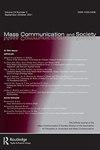Populist Hyperpartisans?: The Interaction Between Partisan Media Exposure and Populism in the 2020 US Presidential Election
IF 2.7
2区 文学
Q1 COMMUNICATION
引用次数: 0
Abstract
ABSTRACTAspects of our political world brought to the forefront in recent years include the impact of declining media trust and a surge of populist politicians around the globe. Highlighting those aspects, this study utilizes representative data from the American National Election Studies (ANES) collected during the 2020 US Presidential Election. We examine the relationship between use of different media (mainstream liberal, mainstream conservative, and hyper-conservative) and media trust as well as the moderating role of populist beliefs. Results found that hyper-conservative media use and anti-elitist populist beliefs are negatively associated with media trust while liberal media use is positively associated with media trust; mainstream conservative media use is unrelated to media trust when controlling for other media types and populist beliefs. This lack of a main effect for conservative media is clarified by examining the interaction with anti-elitist populism, which shows increased use of conservative media for individuals with low levels of populist beliefs is associated with increased media trust while the opposite is true for those high in populist beliefs.DisclaimerAs a service to authors and researchers we are providing this version of an accepted manuscript (AM). Copyediting, typesetting, and review of the resulting proofs will be undertaken on this manuscript before final publication of the Version of Record (VoR). During production and pre-press, errors may be discovered which could affect the content, and all legal disclaimers that apply to the journal relate to these versions also. Disclosure StatementThe authors have no conflicts of interest to disclose.Figure 1. Interaction Between Populism and Media Use Predicting Media Trust.Display full sizeNote. Low and high values are visualized using one standard deviation above and below the mean for populism and one standard deviation above the mean and zero for all media variables.Notes1 The Sean Hannity radio show was included under hyper-partisan as Ad Fontes (Citation2023) notes it is more opinion-based than the Hannity television show.2 While the alpha is slightly below the traditional cutpoint of .7, we chose to keep the three items to ensure wider concept validity for our scale. We also re-ran all results using just the two questions that had been validated in prior scholarship, and the pattern of significance is identical..3 We also ran models using more extensive media controls accounting for entertainment programing, social media use, and others. The pattern of results was identical to what is presented here and can be seen in the online supplement.Additional informationNotes on contributorsMyiah J. HutchensMyiah J. Hutchens (Ph.D., The Ohio State University) is Chair and Associate Professor in the Department of Public Relations within the College of Journalism and Communications at the University of Florida. Her research interests include political communication and political discussion.Brittany ShaughnessyBrittany Shaughnessy (MA, Virginia Tech) is a PhD student in the College of Journalism and Communications at the University of Florida. Her research interests include political communication, rural resentment, and political discussion.Eliana DuBosarEliana DuBosar (MA, University of Florida) is a PhD candidate in the College of Journalism and Communications at the University of Florida. Her research interest includes political communication and selective exposure.民粹主义空前?2020年美国总统大选中党派媒体曝光与民粹主义的互动
摘要近年来,媒体信任度的下降和全球民粹主义政治家的激增,成为我们政治世界的热点问题。为了突出这些方面,本研究利用了2020年美国总统大选期间收集的美国国家选举研究(ANES)的代表性数据。我们研究了不同媒体(主流自由主义、主流保守主义和超保守主义)的使用与媒体信任之间的关系,以及民粹主义信仰的调节作用。结果发现,极端保守的媒体使用和反精英的民粹主义信仰与媒体信任呈负相关,而自由的媒体使用与媒体信任呈正相关;在控制其他媒体类型和民粹主义信仰时,主流保守媒体的使用与媒体信任无关。通过检查与反精英民粹主义的相互作用,可以澄清这种对保守媒体缺乏主要影响的情况,这表明,民粹主义信仰水平低的个人增加使用保守媒体与增加媒体信任有关,而民粹主义信仰水平高的人则相反。免责声明作为对作者和研究人员的服务,我们提供了这个版本的已接受的手稿(AM)。在最终出版版本记录(VoR)之前,将对该手稿进行编辑、排版和审查。在制作和印前,可能会发现可能影响内容的错误,所有适用于期刊的法律免责声明也与这些版本有关。声明作者无利益冲突需要披露。图1所示。民粹主义与媒介使用的互动关系预测媒介信任。显示全尺寸。对于民粹主义,使用高于平均值和低于平均值的一个标准差,对于所有媒体变量,使用高于平均值和零的一个标准差来可视化低值和高值。注1:正如Ad Fontes (Citation2023)所指出的那样,肖恩·汉尼提的广播节目被列入超级党派之列,它比汉尼提的电视节目更基于观点虽然alpha值略低于传统的临界值0.7,但我们选择保留这三个项目,以确保我们的量表具有更广泛的概念有效性。我们还重新运行了所有的结果,只使用两个问题,已在先前的学术验证,和显著性模式是相同的我们还运行了使用更广泛的媒体控制的模型,包括娱乐节目、社交媒体使用等。结果的模式与这里展示的相同,可以在在线补充中看到。smyiah J. Hutchens(俄亥俄州立大学博士)是佛罗里达大学新闻与传播学院公共关系系的主席和副教授。主要研究方向为政治传播与政治讨论。Brittany Shaughnessy(硕士,弗吉尼亚理工大学)是佛罗里达大学新闻与传播学院的博士生。她的研究兴趣包括政治传播、农村怨恨和政治讨论。Eliana DuBosar,佛罗里达大学文学硕士,佛罗里达大学新闻与传播学院博士研究生。她的研究兴趣包括政治传播和选择性曝光。
本文章由计算机程序翻译,如有差异,请以英文原文为准。
求助全文
约1分钟内获得全文
求助全文
来源期刊

Mass Communication and Society
COMMUNICATION-
CiteScore
6.90
自引率
3.30%
发文量
58
期刊介绍:
Mass Communication and Society" mission is to publish articles from a wide variety of perspectives and approaches that advance mass communication theory, especially at the societal or macrosocial level. It draws heavily from many other disciplines, including sociology, psychology, anthropology, philosophy, law, and history. Methodologically, journal articles employ qualitative and quantitative methods, survey research, ethnography, laboratory experiments, historical methods, and legal analysis.
 求助内容:
求助内容: 应助结果提醒方式:
应助结果提醒方式:


